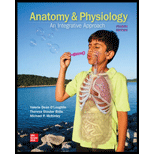
ANATOMY+PHYSIOLOGY-CONNECT ACCESS
4th Edition
ISBN: 9781264265398
Author: McKinley
Publisher: MCG
expand_more
expand_more
format_list_bulleted
Question
Chapter 12, Problem 2CAL
Summary Introduction
Introduction:
Neural tissue involves two types of cells: neurons and neuroglia. Neuroglia or glial cells are the supporting cells of the nervous system. These cells protect the neurons from damage and provide a protected environment.
Expert Solution & Answer
Want to see the full answer?
Check out a sample textbook solution
Students have asked these similar questions
What is the structure and function of Eukaryotic cells, including their organelles? How are Eukaryotic cells different than Prokaryotic cells, in terms of evolution which form of the cell might have came first? How do Eukaryotic cells become malignant (cancerous)?
What are the roles of DNA and proteins inside of the cell? What are the building blocks or molecular components of the DNA and proteins? How are proteins produced within the cell? What connection is there between DNA, proteins, and the cell cycle? What is the relationship between DNA, proteins, and Cancer?
Why cells go through various types of cell division and how eukaryotic cells control cell growth through the cell cycle control system?
Chapter 12 Solutions
ANATOMY+PHYSIOLOGY-CONNECT ACCESS
Ch. 12.1 - Prob. 1WDYLCh. 12.1 - Prob. 2WDYLCh. 12.1 - Prob. 3WDYLCh. 12.2 - Prob. 4WDYLCh. 12.2 - Prob. 5WDYLCh. 12.2 - Prob. 6WDYLCh. 12.2 - Prob. 7WDYLCh. 12.2 - Prob. 8WDYLCh. 12.3 - Prob. 9WDYLCh. 12.4 - If a person has a brain tumor, is it more likely...
Ch. 12.4 - Prob. 11WDYLCh. 12.4 - Prob. 12WDYLCh. 12.4 - Prob. 13WDYLCh. 12.5 - Prob. 14WDYLCh. 12.5 - Prob. 15WDYLCh. 12.6 - Prob. 16WDYLCh. 12.6 - Prob. 17WDYLCh. 12.7 - Prob. 18WDYLCh. 12.7 - Prob. 19WDYLCh. 12.7 - Prob. 20WDYLCh. 12.8 - How are EPSP and IPSP graded potentials...Ch. 12.8 - Prob. 22WDYLCh. 12.8 - How does depolarization and repolarization occur...Ch. 12.8 - Prob. 24WDYLCh. 12.8 - Prob. 25WDYLCh. 12.9 - Prob. 26WDYLCh. 12.9 - Prob. 27WDYLCh. 12.9 - Prob. 28WDYLCh. 12.10 - Prob. 29WDYLCh. 12.10 - Prob. 30WDYLCh. 12.10 - Prob. 31WDYLCh. 12.11 - Prob. 32WDYLCh. 12.11 - Prob. 33WDYLCh. 12 - Prob. 1DYKBCh. 12 - Prob. 2DYKBCh. 12 - Prob. 3DYKBCh. 12 - Prob. 4DYKBCh. 12 - Prob. 5DYKBCh. 12 - Prob. 6DYKBCh. 12 - _____ 7. An action potential is generated when...Ch. 12 - Prob. 8DYKBCh. 12 - Prob. 9DYKBCh. 12 - Prob. 10DYKBCh. 12 - What are the four structural types of neurons? How...Ch. 12 - Prob. 12DYKBCh. 12 - How does myelination differ between the CNS and...Ch. 12 - Describe the procedure by which a PNS axon may...Ch. 12 - Prob. 15DYKBCh. 12 - Prob. 16DYKBCh. 12 - Explain summation of EPSPs and IPSPs and the...Ch. 12 - Graph and explain the events associated with an...Ch. 12 - Prob. 19DYKBCh. 12 - Prob. 20DYKBCh. 12 - Prob. 1CALCh. 12 - Prob. 2CALCh. 12 - Prob. 3CALCh. 12 - Prob. 4CALCh. 12 - Sarah wants to call her new friend Julie and needs...Ch. 12 - Over a period of 6 to 9 months, Marianne began to...Ch. 12 - Prob. 2CSLCh. 12 - Prob. 3CSL
Knowledge Booster
Learn more about
Need a deep-dive on the concept behind this application? Look no further. Learn more about this topic, biology and related others by exploring similar questions and additional content below.Similar questions
- In one paragraph show how atoms and they're structure are related to the structure of dna and proteins. Talk about what atoms are. what they're made of, why chemical bonding is important to DNA?arrow_forwardWhat are the structure and properties of atoms and chemical bonds (especially how they relate to DNA and proteins).arrow_forwardThe Sentinel Cell: Nature’s Answer to Cancer?arrow_forward
- Molecular Biology Question You are working to characterize a novel protein in mice. Analysis shows that high levels of the primary transcript that codes for this protein are found in tissue from the brain, muscle, liver, and pancreas. However, an antibody that recognizes the C-terminal portion of the protein indicates that the protein is present in brain, muscle, and liver, but not in the pancreas. What is the most likely explanation for this result?arrow_forwardMolecular Biology Explain/discuss how “slow stop” and “quick/fast stop” mutants wereused to identify different protein involved in DNA replication in E. coli.arrow_forwardMolecular Biology Question A gene that codes for a protein was removed from a eukaryotic cell and inserted into a prokaryotic cell. Although the gene was successfully transcribed and translated, it produced a different protein than it produced in the eukaryotic cell. What is the most likely explanation?arrow_forward
- Molecular Biology LIST three characteristics of origins of replicationarrow_forwardMolecular Biology Question Please help. Thank you For E coli DNA polymerase III, give the structure and function of the b-clamp sub-complex. Describe how the structure of this sub-complex is important for it’s function.arrow_forwardMolecular Biology LIST three characteristics of DNA Polymerasesarrow_forward
arrow_back_ios
SEE MORE QUESTIONS
arrow_forward_ios
Recommended textbooks for you
 Medical Terminology for Health Professions, Spira...Health & NutritionISBN:9781305634350Author:Ann Ehrlich, Carol L. Schroeder, Laura Ehrlich, Katrina A. SchroederPublisher:Cengage Learning
Medical Terminology for Health Professions, Spira...Health & NutritionISBN:9781305634350Author:Ann Ehrlich, Carol L. Schroeder, Laura Ehrlich, Katrina A. SchroederPublisher:Cengage Learning Essentials of Pharmacology for Health ProfessionsNursingISBN:9781305441620Author:WOODROWPublisher:Cengage
Essentials of Pharmacology for Health ProfessionsNursingISBN:9781305441620Author:WOODROWPublisher:Cengage Concepts of BiologyBiologyISBN:9781938168116Author:Samantha Fowler, Rebecca Roush, James WisePublisher:OpenStax CollegeBasic Clinical Lab Competencies for Respiratory C...NursingISBN:9781285244662Author:WhitePublisher:CengageSurgical Tech For Surgical Tech Pos CareHealth & NutritionISBN:9781337648868Author:AssociationPublisher:Cengage
Concepts of BiologyBiologyISBN:9781938168116Author:Samantha Fowler, Rebecca Roush, James WisePublisher:OpenStax CollegeBasic Clinical Lab Competencies for Respiratory C...NursingISBN:9781285244662Author:WhitePublisher:CengageSurgical Tech For Surgical Tech Pos CareHealth & NutritionISBN:9781337648868Author:AssociationPublisher:Cengage

Medical Terminology for Health Professions, Spira...
Health & Nutrition
ISBN:9781305634350
Author:Ann Ehrlich, Carol L. Schroeder, Laura Ehrlich, Katrina A. Schroeder
Publisher:Cengage Learning


Essentials of Pharmacology for Health Professions
Nursing
ISBN:9781305441620
Author:WOODROW
Publisher:Cengage

Concepts of Biology
Biology
ISBN:9781938168116
Author:Samantha Fowler, Rebecca Roush, James Wise
Publisher:OpenStax College

Basic Clinical Lab Competencies for Respiratory C...
Nursing
ISBN:9781285244662
Author:White
Publisher:Cengage

Surgical Tech For Surgical Tech Pos Care
Health & Nutrition
ISBN:9781337648868
Author:Association
Publisher:Cengage
Cancer Types SIMPLY explained! MEMORIZE them QUICKLY and EASILY!; Author: CancerEdInstitute;https://www.youtube.com/watch?v=dEBi-yvSWmQ;License: Standard Youtube License